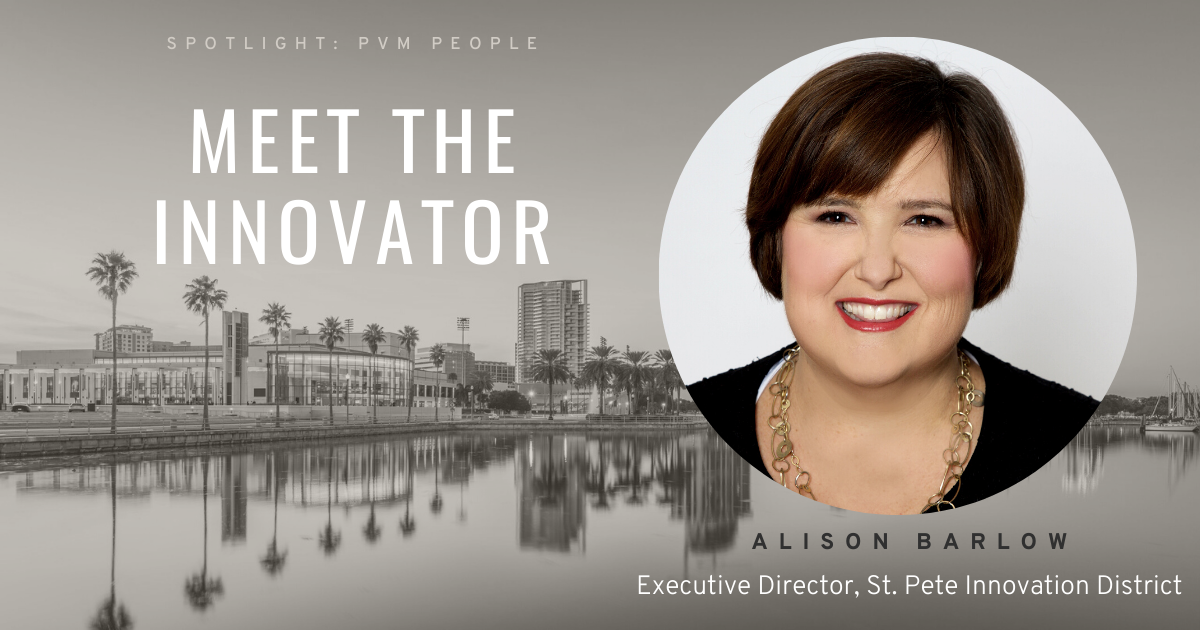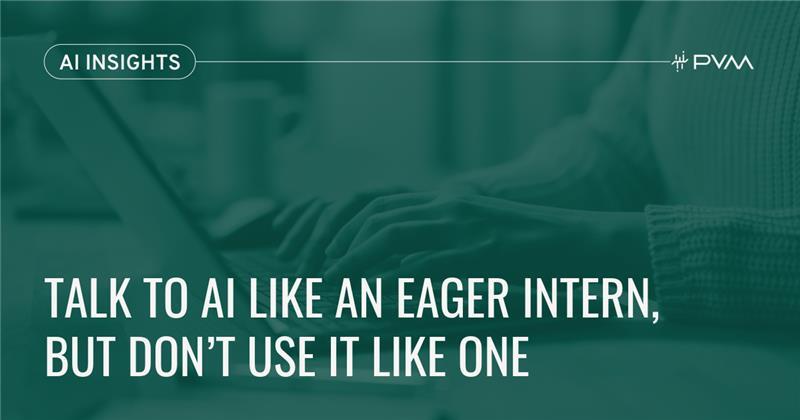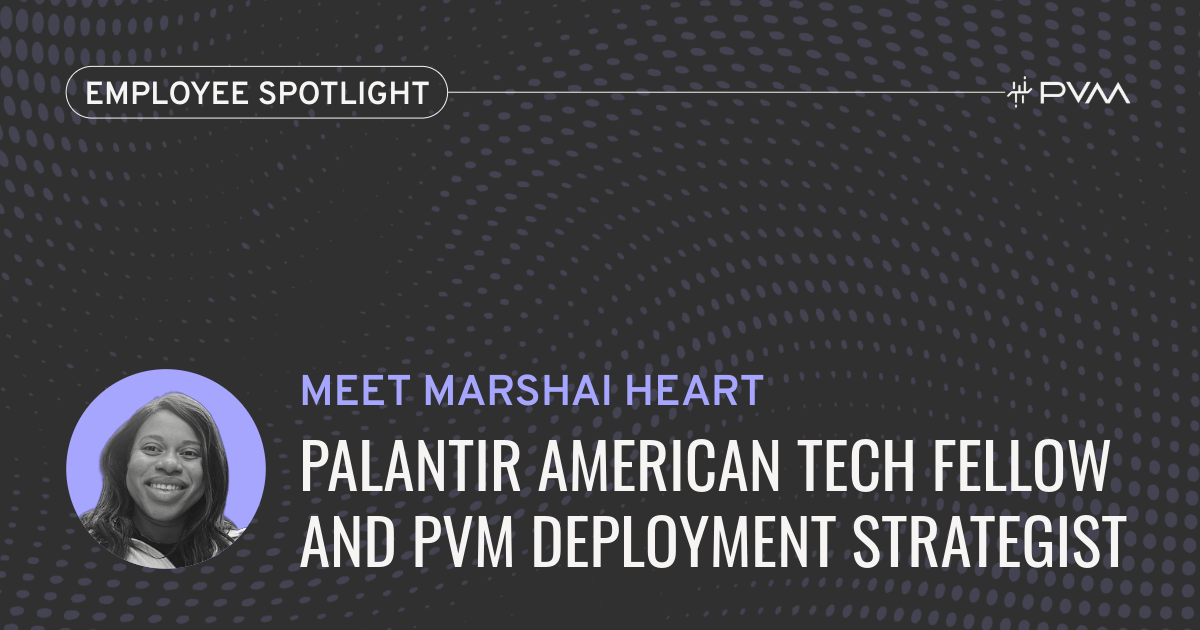A Marine’s Lesson in Innovation — From a Freezing Cold Field Mission in Korea to Today
By Bret Frederick When I was a young Marine, I worked as a systems administrator on the Marine Corp’s air battle planning system. It was part of a...
I NEED HELP WITH...
I'M WORKING WITH...
INDUSTRIES

At PVM, we have extensive experience unlocking the power of data and helping our clients achieve their missions in federal, state, and local governments, as well as commercial sectors. In today's data-driven world, organizations across all sectors recognize that their success hinges on harnessing the full potential of their data.

ABOUT US


We had the pleasure of sitting down with Alison Barlow, the Innovation District's Executive Director, and learning more about her, her work with the Maritime and Defense Hub, and her deep roots in St. Petersburg. She’s a true advocate of this big-small city we call home and we loved learning what's next for this innovator.
When I read the job description it was very eclectic, but that fit me perfectly. My own work history is eclectic.
- Alison Barlow
We moved here when I was four years old for my father’s job. My dad was in the corporate office of State Farm Insurance and decided to become an agent. At that time with State Farm, it was sort of a combination of lottery systems for where you would go. The city you ended up in was half selection, half luck. And we ended up here in St. Pete! I grew up here, went to St. Jude’s and Boca Ciega High School. For college, I went to Florida State and then worked for a few years around Florida. I then ended up in Washington, D.C. for graduate school at American University. My undergraduate degrees are in hospitality administration and my master's was an MBA with a concentration in technology.
After I completed my master’s in D.C., the job market in Florida was not great and it was going crazy in D.C. So, I stayed. I was there for 15 years, doing technology consulting, project management, and worked for the Department of Defense. I came back to St. Petersburg in 2007 and bought a house in Old Northeast. When I moved back here, I got involved in Leadership St. Pete but was not in the city all the time. I traveled a lot doing freelance consulting. In 2014, I was hired by St. Petersburg College (SPC) to run their collaborative labs program, which got me off the road and back here. I was at SPC until this role came up and have been with the Innovation District for four years now.
There were a lot of conversations happening between senior leaders at Bayfront Hospital, like Dr. Kenika Tomalin (who later become deputy mayor) and members of the St. Petersburg Downtown Partnership, about creating a business district. When I was growing up in St. Pete, there weren’t neighborhoods—we denoted areas by intersections. But we’re zoned by neighborhoods here and they grew over the years. Business districts, or corridors, were separate. But that’s changing. More neighborhoods are asking for businesses in their neighborhoods and vice versa.
Leaders at the anchor institutions in the Innovation District recognized this back in 2015 and were looking for ways to optimize collaborations among themselves. When Dr. Tomlin moved to the mayor's administration, she brought this forward as one of the agenda items. Mayor Kreisman really took it on and backed some initial efforts. The Innovation District was formally created in April of 2016. The Innovation District is formally a 501(c)(6) nonprofit with anchor institutions contributing funds to make it happen.
I joined in June 2017. My role is focused on working on three things, per best practices from other innovation districts and research from the Brookings Institute. They include:
The Maritime and Defense Hub is the culmination of all those elements. We’re focused on connectivity, collaboration, and education—especially around STEM education.
I saw this job posting on Facebook from a friend who was loosely involved with the Innovation District. When I read the job description it was very eclectic, but that fit me perfectly. My own work history is eclectic. The one thing I was not as strong in was economic development, but that perceived weakness has worked out great—it led to strong partnerships. We work regularly with the city’s economic development team, the county’s economic development team, and others, leaning on each other for advice and support.
St. Pete has target industries—data analytics, financial services, specialized manufacturing, marine and life sciences, and creative arts and design. The Hub and the Innovation District are trying to help grow these target industries in St. Pete. We’re growing them to increase the opportunities for jobs—specifically for graduates and locals. We want to keep our talent here in St. Petersburg. We want to create a cluster where when you want to shift your job or your role, you can look to businesses within the Innovation District and the Hub.
If we can build this cluster of jobs and a new market, we can attract dollars—investment dollars, grant dollars, etc., and ideally, wages start to grow locally as well. You have a competition for local talent.
Additionally, we see another opportunity in the Innovation District. We want to not only attract new businesses and job opportunities but also want to break ground on new spaces. We want to build connectivity between our spaces and the traditional anchor businesses—new restaurants, pedestrian walkways, housing, etc.
I think one of the most pressing issues right now in St. Pete is housing, specifically affordable housing. For me, this question is two-fold—it is a question of rent prices and cost of living, as well as a question of salary. We have to fight for higher wages here. What I think the Innovation District can do is advocate for opportunities for multi-family housing within our boundaries. We can help influence and support initiatives happening in nearby neighborhoods, and we can take the lead from our neighborhoods on what they would like to see.
The Innovation District can help work on the wage side of the issue. It’s a bit of the chicken and the egg—we want to bring in companies and grow them, but it will also cause a near-term issue with lack of space. For me, solving this housing issue isn’t a straightforward solution. There are lots of things that need to work together.
We, as well as the City, have been working on being intentional about equity in St. Pete—around economic development—and within the Innovation District. We look at equity in a few ways—partner diversity, talent diversity, and workforce diversity. For the Hub, whenever possible, we tried to hire suppliers and contractors who were local minority-owned businesses. We’ve also tried to talk with our other partners within the District about alignment on these hiring practices.
Finally, we’ve tried to think about how we can help increase access to public transportation. The Innovation District is collectively looking at models in different cities to see if there is something we can implement here in St. Pete. I definitely think there is an opportunity here for us to contribute to the housing solution in some way.
The variety of my day, the cool work our partners are doing, and my opportunity to highlight it to others. It gives me energy and I’m continually amazed by what is happening in the District. For instance, the new Duke Energy substation is something that is innocuous, but so innovative. I also love that I get to tell the stories of our partners, to the Chamber, to the County, to the City. I joke with our researchers that I often screw it all up when I share their work, but the passion is there!
I think I’m most excited about the potential of this space. I believe it’s going to cause a ripple effect of change and I think we’re already seeing it. I also think we’re going to be able to do more in marine science and environmental spaces. We have a project that we’re working on behind the scenes that we’ve been waiting to launch, but we couldn’t really do it until the Hub was created. We’re going to be reigniting some round-table discussions around environmental sustainability this year, and hopefully, we’ll see some really collaborative, impactful work come out of them.
Also, snuggle breaks! Hoping to work with Friends of Strays this year to bring in adoptable puppies and kittens for mental health breaks.
St. Petersburg is a big small town. You’re going to get a lot of the culture, arts, and restaurants—like you would have in a large city—but with a collaborative, welcoming community that has a small-town feel. Plus, we’re on the water.
Here, if you want to get involved with the community, you can have an impact. If you’re trying to grow a business, there are people here to help you. And St. Pete is comprised of an interesting mix of people—multigenerational families that have been here for years, new transplants, young people, etc.
It’s a true integration of the work/play lifestyle that so many people are looking for. The commute isn’t terrible. Your job and your life are more balanced and integrated. Just know that you may run into someone you know at the grocery store while in gym clothes (laughs).

By Bret Frederick When I was a young Marine, I worked as a systems administrator on the Marine Corp’s air battle planning system. It was part of a...

By Sydney Metzmaker AI is often described as an intern: eager, capable, and full of potential, but in need of specific direction and a bit of...

We sat down with Marshai Heart, a recent graduate of Palantir’s American Tech Fellowship who has since joined PVM as a Deployment Strategist. With...